We associate the French with beauty, refinement, elegance, grandeur. These are visible everywhere in Paris, as is occasional disorder and chaos, but underlying them is a discipline that is harder to discern. This year I was in Paris for more than two months: the first at the end of January to visit and see friends, and then again from mid-March to late April, for surgery. Much of what I read and hear about France does not parallel my experience . . .so I’ve compiled a few short essays here.
Paris for the tourist
There is a lot of traffic in Paris; it is heavily visited and it can be exhaustingly crowded. Many of the stores and restaurants are formulaic, although less so than in New York where I have lived for many years. The metro is often packed, the accordion-playing street musicians predictable. Public toilets are self-cleaning but spoiled by vagrants.
Much of the city is a theme park to French history. Last year I re-visited the Musée du Quai d’Orsay and the state rooms at Versailles, but the crowding was unbearable. There are other things to see. Years ago, a student, I walked into the medieval Sainte Chapelle, sat down and enjoyed the tall stained glass windows. I remembered this as I passed by yesterday on the Isle de la Cité. However, there are now tickets, a line, and a security screening. I didn’t want to spoil the memory, so I kept on walking.
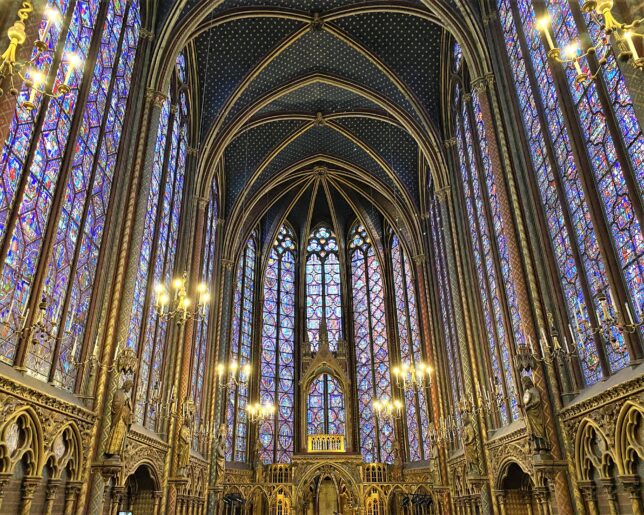
My German teacher says that European tourism changed when the iron curtain fell in the 1990’s, opening up travel from eastern Europe. Later there were large numbers of visitors from Asia. Visitors spend money; there is a lot to do, and the business is welcomed. Yet many European cities are theme parks, pushing out real life, open air museums, where crowds of visitors look at each other. There is more than a bit of this in Paris. The complaint is not only mine. The Louvre Museum is limiting visitors to 30,000 per day, a proposal which will be tested this summer.
According to its director, Laurence des Cars, people want to return to museums and rediscover the pleasure of contemplating art, directly, not through a screen, to share this experience, across generations and in families. Doing so should be as comfortable as possible and should offer exceptional moments in overcharged lives. If the Louvre, a magnificent place, with extraordinary spaces, is saturated with visitors, a part of that pleasure is lost. (See Financial Times interview, April 21, and FranceInter interview on You-tube 2023, copy the link here: https://www.youtube.com/watch?v=iYJmTNH-G6s)
I have seen the great sites. I now prefer the view of Notre Dame at a distance while its roof is being rebuilt. I want to talk to people, focus on old friends, visit quieter places or those that hold my memories. (I’ll revisit the Louvre, when its new program is in place. . . )
January 27, on the rue de Vaugirard
In Paris since Friday after five weeks of traveling, I am tired and happy in friends’ comfortable one bedroom apartment on the rue de Vaugirard. It is at the rear of the building, quiet, accessible with a tiny elevator—the kind that was added years after the building’s construction. It has a small windowed modern kitchen, a dining table that seats four, a fold-out couch in the living room, enough room for dinner and sleepover guests. I am in the 15th arrondissement, across from the Hôpital Necker for sick children, which is very convenient, near three metro stops and within easy walking distance of shopping, the Montparnasse train station and the 7th and 6th arrondissements.
Tonight, I am having dinner guests, an old friend, and her brother and sister-in-law. My friend told me that the others eat simply, without sauces, so my plan for a boeuf bourgignon is for another time. Shopping on this section of the rue de Vaugirard is limited, so yesterday I walked across the Boulevard Pasteur to rue Lecourbe, where the stores are more varied and interesting. I stopped first at a butcher and had him slice two chicken breasts into cutlets. I also asked for two herb sausages, presumably pork, for another day. Then I shopped at a Franprix, a chain market, for rice, mustard, breakfast food, and dried prunes for a dessert I had tried on Sunday, when friends invited me to at a restaurant in the 7th. I also bought two soft cheeses, one goat, as these are cheaper in the the Franprix and will add one or two more at the adjacent cheese store later today. On my way back, I stopped at a nearby wine store, Nicolas, for Armagnac and wine.
Armagnac, which I used to stew the prunes, is a brandy of various white wines, cellared in oak barrels. My bottle was from Chateau de Laubade, in lower or “bas” Armagnac in southwest France. It was cellared for 12 years and cost 45 euros. To serve with the chicken, the wine merchant recommended a 2021 pinot noir, from the Domaine de l’Aigle, also in the south of France, about 15 euros. It was very good, indeed the wine merchant made two very good recommendations while I was on Vaugirard; the chicken was also very good, less so my version of the prunes, which were more delicate in the restaurant.
February 6, the Marais
Yesterday, an old friend invited me to lunch in the Marais with her daughter and two grandchildren. Her daughter recently found a studio apartment near the Place des Vosges, in a walk-up building, overlooking a garden courtyard at the rear and a street on the front. It has a sleeping loft, with 17th or 18th century half-timbered walls and high ceilings. A 19-year-old grandson lives there, preparing for his concours, the competitive entrance exams for France’s grandes écoles. France has a very competitive system, where students spend over a year preparing for examinations that determine acceptance at some of its most prestigious universities. Classes and study take up nearly all of his time, and there are no guarantees. (I worked hard in school, but competition was more varied, subjective, and not based on a single test.)
Downstairs is a small, classic, restaurant, where my friend invited us all to lunch. I had confit de canard with potatoes and was full for the rest of the day.
Afterwards we went to the Musée de la Chasse et de la Nature, which has an extraordinary collection of animal trophies and guns. Man’s long relationship to beautiful animals, that is killing them, is not at all hidden, and the museum is beautiful, with careful attention to detail. The renovated buildings, two old, aristocratic hôtels, are as wonderful as the collection. The staircase rails are bronze branches, some light fixtures a combination of bronze antlers, bronze branches and organic glass bulbs; the walls are painted in deep rich colors, the exhibits are in 19th century display cases. The effect is that of a private, almost over-furnished residence, intimate and exquisite.
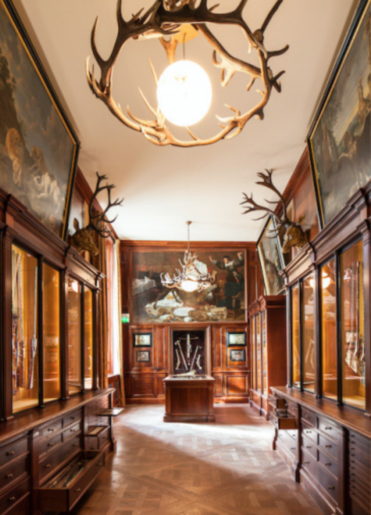
At the end of the afternoon, we went shopping for a replacement for my shabby winter coat. My friend reminded me that men dislike shopping. She was right; I am intimidated in stores, but she is twice widowed, a mother and a grandmother, and like my own mother a lifetime ago, an effective shopper.
Affluent American women often enjoy, exquisite, unique and expensive purchases. Less so in the French bourgeoisie, where elegant women often take pride in careful expenditure, suitable or chic, but reasonably priced. Under her direction, I found a new coat, with a hood, in dark blue, on sale, and marked down from 250 euros to 98. I invited my friend for a cappuccino afterwards. (Another friend in London has now given me a possum and marino-wool red cap to wear with it.)
February 17
Food was again my destination yesterday, this time at the Marché Couvert des Enfants Rouges (Covered Market of Red Children) in the Marais district, introduced to me by my friend Alexandre, and which dates to the early 17th century. There is generally more choice and activity in the morning, but I walked there in the early afternoon, after some hours reading and exercising at home.
Walking itself is part of a destination. When I look at people and stores, I indulge my attractions, but also frequently imagine that I am furnishing an apartment, equipping a kitchen, buying food, or stopping in a café or restaurant.
My walk was east on the rue de Vaugirard, to the rue du Cherche-Midi, across the Boulevard Montparnasse and into the 6th arrondissement. On narrow old Cherche-Midi, the stores are rich and interesting, carefully put together: a cheese shop, a kitchenware place, a dessert bakery/café that I eventually visited, an 18th century hôtel with a closed museum. As I approached the Seine, and crossed the Boulevard St. Germain, the streets were more crowded, the cafés less interesting.
I crossed the river, the Isle de la Cité, and again the Seine, looking at grand 19th century theaters on the Place du Châtelet, the medieval tower of St. Jacques behind them, and then I walked into the Marais, which dates to the Renaissance. I stopped again at the large BHS department store, for no better reason than to use the toilets. These are on the top floor, on my way out, I stopped at the Figaret boutique. Figaret’s dress shirts were my ideal of elegance thirty years ago. Here they were on sale at 40 or 50% off. I enjoyed looking, and the saleswoman warned me that the fin des soldes was an opportunity, but now, looking was for the memory of buying in Paris, at another time, when I worked in an office in New York and took my shirts to the laundry. Now I wash and iron them myself.
I continued north, past the hôtel that houses the national archives. There was a sign for an exhibit on the last, deposed, royal family’s years at the Tuileries (1789-92), but the opening was in March. The Marché couvert des Enfants Rouges is a bit further up, on the rue de Bretagne, near the Square du Temple, where the royal family was emprisoned prior to the executions of Louis XVI and Marie Antoinette in 1793. North of the square and adjacent to the market entrance, the rue de Bretagne is a paradise of food and cafés. A Maison du Chocolat, a cookie shop, a smoked salmon place, a small tourist hotel. . . I entered the market, which is quiet in the late afternoon. The vendors were in meeting–things are organized and done the right way in France–which is not always the same thing as being constantly available. So I waited for help at the cheese counter.
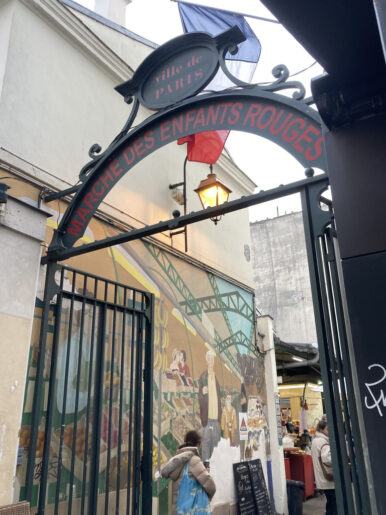
A young woman, a niece of the owner, came to help me; I chose a goat cheese covered in ash, a buffalo camembert, and a third cheese, that I am trying now. I don’t know its name, but tastes like raw milk with herbs. I picked up two apples, for the cheese, but relented and later picked up a baguette tradition on the rue de Vaugirard. After dropping my purchases at the apartment, I walked again to the Nicolas wine shop on the Avenue Pasteur. The same salesman gave me another great red wine recommendation, for goat cheese, a 2021 Valencay blend, from the Loire Valley, at 8 or 9 euros.
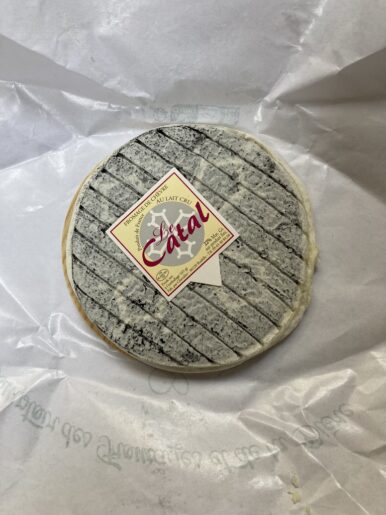
February 18
My primary preoccupation is apparently food, but there is also swimming . . I took the metro yesterday to the Sablons station in Neuilly-sur-Seine and walked to the Centre Aquatique, a covered complex of three pools, including a 25 meter lap pool, which is not usually overcrowded. The staff at the door is friendly, the changing rooms individual and very clean; the code-controlled lockers secure and easy to use. Swimming in Paris can be a nightmare; the public pools are very busy and there are few rules for sharing lanes, if there are lanes. But in Neuilly, I’m able to swim in reasonable peace with courteous fellow-swimmers. The pool is closing next summer for an estimated 18-month renovation—unfortunately for my visit here next year. For now, it is conveniently located, a five minute walk to my close and oldest friends in France, F and C, who had invited me to dinner.
Near them, on the rue de Chézy, is another small, recently-opened cheese shop, owned by the green grocer a few doors away. It has an attractive glass front, display cases on the sides and a counter at the back. Looking in from the street, I eyed some jams and asked the young salesman whether these were the best in existence. He assured me that they were and suggested, that given my culture, I might prefer the bitter orange alternative. I asked what he thought my culture was; English, he said. This is common in France, where some assume we are English if not the type of American they expect. Still, this young man was not just a salesman but also a trained specialist. His work was preceded by specialized schooling in cheeses; his knowledge is detailed.
February 20, a day in the suburbs
Yesterday, Sunday, I took a train to Issou-Porcheville, 16 stops and an hour northwest of Paris, along the Seine river, where friends had scheduled to pick me for lunch at their place. I was early at the Gare de St. Lazare, and so took an earlier train than we had agreed, assuming that I would have a coffee while waiting, at the Issou-Porcheville station.
Isn’t there a village and café at every train station in France? Not here, Issou-Porcheville is merely a commuter stop between two villages. A local told me that the village was a long walk, about a kilometer. Still not having absorbed that a kilometer is only about .62 miles, I turned back and waited at the train stop. The man I spoke to was black, as were a lot of the people at the station. It is remarkable how multicultural Paris is, multi-accented and French speaking. I spoke briefly with a woman from the Ivory Coast, who was waiting for the bus and listening to what sounded like a political rally on her phone. I asked another man coming out the station whether there was a bathroom or a café nearby. Nothing, he said and recommended the bushes in good humor. We had a conversation a bit later. He is not local, and not black, but the employee of a charter bus company handling alternative transportation, while repairs are made to one of the RER regional transportation lines. Other weekends he is at other locations; the public would not tolerate closures during the week, he said.
My friends own a pleasant house close to the Seine river. When I arrived, their daughter-in-law introduced herself, and brought her three children to the back terrace to meet me. She told each of them to say hello, allowing the middle one to hide behind her legs. Her husband, an engineer in his 30’s, greeted me in an open and friendly manner. I asked if we had met previously; we could not remember, and if so it was many years ago. This family is not formal, but there is traditional discipline. Aperitif was in the living room, with a very interesting conversation about the preservation of archival documents, followed by lunch at a large table in the dining room. This was a lamb stew, red or white wine, a cheese course with bread, a homemade apple cake, and the excellent remains of the prior day’s chocolate cake.
After lunch we all took a walk on a public trail along the Seine, below the house. We passed a number of house boats—there are also many in Paris–and we saw an old, deteriorated and modest yacht, Winston Churchill’s Amazone, built in England in the 1930’s. It is forlorn, seemingly forgotten, although there is a article in French, with good pictures, posted on-line at: https://www.bateaux.com/article/22238/amazone-yacht-de-winston-churchill-vente
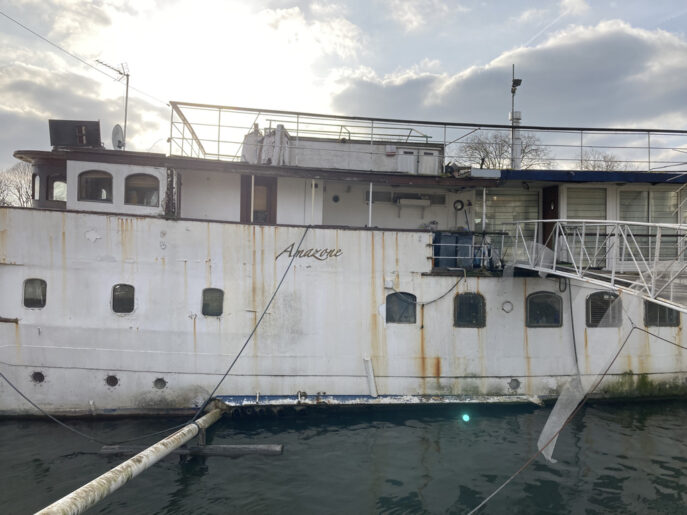
After lunch, I joined the children on another train back to Paris, not a commuter line, but a regional express, leaving from a larger town nearby. It was overcrowded with people and luggage in the aisles, not at the standard of other train lines I have seen. Most of the passengers were young, returning home from the weekend. The trip into the Gare de St. Lazare was about 45 minutes.
February 20, a detour to Nîmes
Last week I traveled with my very good friend Catherine to Nîmes on the high speed Train à Grande Vitesse (TGV) leaving from the Gare de Lyon. We booked rooms at a cheap Ibis Budget hotel near the Nîmes train station, very basic and clean, at only 50 euros a night.
Nîmes is quiet, not dead but a little tired in places, a ville de province. History has passed it by, and yet it hasn’t. It has some of the best Roman monuments in Europe: a perfectly formed temple set on a tall pedestal, with tall fluted, Corinthian columns, and a sculpturally beautiful coliseum. Both are beautifully emphasized by 19th century urban planning, a large square for the temple and a surrounding street for the stadium. A Roman museum, facing the coliseum, is a modern wonder of superb objects and accessible, sophisticated audio-visual displays. There are beautiful parks, a canal and esplanades. Nîmes appears to be doing everything right. There is a food market in the mornings where we had bread and cheese with coffee, and many shops on the streets, although many are not terribly interesting. I saw two supermarkets and visited one. It had everything, but its interior was tired. The property prices are low, the many 19th century buildings handsome. The weather is cold in February, but it is sunny and bright. (The air quality, unfortunately, was low during my visit.) Not a bad place I think; perhaps I should spend more time here. But I am deterred by a sense of isolation—there are no memories for me, no connection, and I know no one in Nîmes.
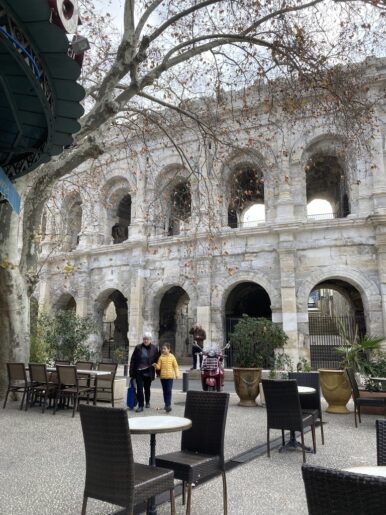
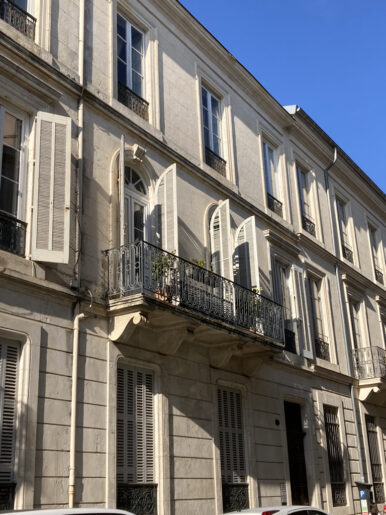
February 21
Yesterday, I was invited to a luncheon in Marnes la Coquette. My friends have told me that more and more Parisians are leaving the crowded center of the old city, settling in the suburban and smaller towns outside its periphery.
I have visited our hostess a few times before, but I was again taken with the beauty of the town and of her apartment, in a large 19th century bourgeois mansion. The ceilings are very tall as are the double French windows, set off from the garden by handsome ornamented rails. The dining table was elegant and the food simple and delicate, a soufflé quiche, salmon and vegetables baked in foil, a tasty white wine, and then crêpes, served with jam, or lemon juice or a chestnut cream.
Hers is a wonderful family that I have known for fifty years. A younger sister is a Catholic nun, who administers an international network of schools for adults and children. With her was a sister from Vietnam, a teacher who lived through difficult circumstances after the communist takeover. Monitoring schools and programs in differing countries and legal systems is astonishingly complex, yet the order seems to be run with simplicity and modesty. I am not a Catholic, not even Christian, but these sisters were a window into a practical world that emphasizes faith.
February 22
Today I had some errands. One of them was getting buttons re-sewn on my new winter coat. I found a small retoucherie on the Avenue Pasteur, owned by a friendly Pakistani couple who said they could take care of it right away. While I was waiting, I decided to get something to eat at a nearby café, forgetting eating in France at one or two o-clock is lunch. I wasn’t particularly hungry, but I decided to go with the flow and ordered a fish casserole. It was baked and served hot with cream and potato in an earthenware ramekin. There were no chunks —the fish had been worked into the mixture—but it was tasty. A small leafy salad was served on the side, with a very good vinaigrette dressing.
At the retoucherie, the owner spoke an accented but very good French. He has lived most of his life in Paris, and he and his wife moved fairly recently to this 15th arrondissement neighborhood. The clients are friendly and courteous, and loyal, he said. Unlike the many overweight women he has seen while visiting friends in England, French women keep themselves well, even older women. They limit how much they eat. They dress carefully and want their tailoring to be well done; they know and are observant to detail. 35 euros for a small alteration is not an issue, but the work has to be done just right.
February 25, pickpockets, etcetera
Thursday, on my way back to the apartment, on metro line 6, the doors opened at Trocadéro. A woman started screaming, and a small crowd went to help her or leaned out of the train to look. I could not see and decided not to join them, but I talked with those around me, a friendly black woman, across from me, who had just boarded, and a small Asian woman sitting on my right. The friendly woman seemed to know something about what was going on, so I asked, and she said that she had heard it was a pickpocket and thought the screaming might be from the victim who wasn’t screaming in French. She explained that this was a frequent problem on this train line, so she is always very protective of her purse. There are groups of young girls who move together in the trains looking for victims. If they’re caught, they claim that they are underage, and they don’t carry documents, so the police let them go. I asked why the police don’t hold them until their parents pick them up. And she said, that it takes too much time, and the girls aren’t deterred because this is how they make their living. She works in a store, she said, and deals with this problem all the time. I thanked her and thought– the police simply haven’t devoted the resources or the will to solving the problem. The small woman to my left, told me that this never happens in Japan. In Japan she explained, you can leave your wallet somewhere and it will be returned to you, or will be left untouched. The punishment for stealing is severe, so no one steals. I asked her if she was Japanese; Cambodian she said. Later someone else explained that the pickpockets are gypsies. They are most frequently on the #1 line, which runs through central Paris, looking for tourists.
I got off the metro one stop early to do some shopping. The butcher and traiteur were both closed for school holidays, so I walked a bit further on the rue Lecourbe, looking for other stores, but many were closed, and I decided to simply make a large salad for guests in the evening. But I did stop at a local branch of the famous patisserie, Le Nôtre, where for 7 or 8 euros each, I bought a mille-feuilles, an éclair, and a flan. The salesman was solicitous and the pastries and packaging gorgeous. When I served them that evening, I put them on a plate in the kitchen and removed the identifying labels on each piece. A guest asked if I had bought them at local pastry shop; I nodded. We each tasted all three of them; they were rich but heavy, a disappointment, and a lesson against attraction to the obvious.
February 26, la nouvelle Athènes
On Friday afternoon, I again met Anne at the Musée Gustave Moreau, the romantic painter of mythical and religious subjects. Her sister-in-law Claude who paints, admires the skill of his art, but for me the mythical and religious themes were less penetrating than some of the impressionist landscapes. (The exception was a copy of Botticelli’s Venus on an a colorful abstract canvas.) The museum is in Moreau’s 19th century house, with originally furnished rooms on the second floor, and two, tall, windowed, atelier floors, added by Moreau to display his work.
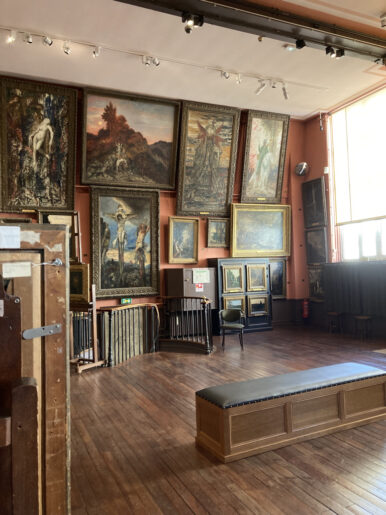
Anne then guided me through Moreau’s 19th century neighborhood, the 9th arrondissement quarter known as la nouvelle Athènes, after the writers and artists who lived there. Also new to me were the wonderful houses on the rue de la Tour des Dames and the early-19th century courtyard buildings around the Square Orléans. I was attracted to many, plain, shuttered facades and small shops, to impressions of intimacy and removal, and then to the opening and grandeur of the nevertheless fairly small Place St. Georges.
February 27
Yesterday, after my German lesson, I hopped on the metro to have lunch with F and C in Neuilly-sur-Seine. The #6 line rides partly on elevated tracks and stations, above the roadway and through the 15th arrondissement. The glorious part of the ride is crossing the Seine, looking directly at the Eiffel Tower, but I also enjoy the elevated stop at Passy, which offers a quick glimpse of the discreet Square d’Alboni behind it, where I have friends.
At the Etoile station, I changed to the #1 line in the direction of La Défense, and exited the train at Les Sablons. I am very familiar with the walk north from the station, on the rue Louis Philippe, and on the way back, I noticed again the plain façade of the street’s remaining 19th century house. The street tends to be shadowed, with a fair amount of traffic; nevertheless this house speaks to a lost dream or fantasy. I peeked through the windows as always, from across the street, and then noticed for the first time an adjacent wall and gate. Among taller, and more recent buildings around it, this house has a private side garden and a garden façade, longer and grander than the one facing the street.
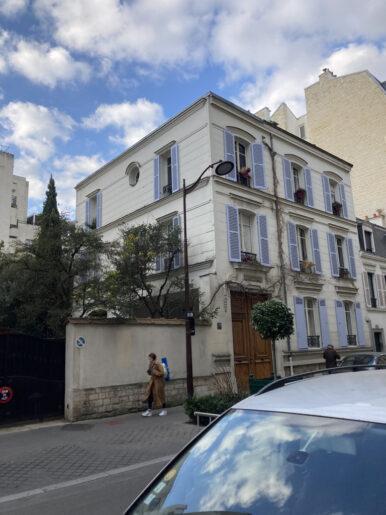
I have written previously about F and C’s apartment on the rue Perronet which pre-dates World War I, as does my own apartment in New York, but theirs is more ornate and refined. Lunch was served in the dining room, under ornate plaster ceilings, facing a row of French doors and an ornate wrought-iron balcony. It was an avocado and grapefruit salad, a small roast beef with a sauce, roasted sliced potatoes, and baked apples with cream and caramel sauce. I cannot cook with the same delicacy and taste as does C, nor with the same plates and elegant service.
Medical care
Americans generally believe that our medical care is the best in the world, at least for those who have good insurance. But my personal experience questions this assumption.
In France, patients choose their doctors and hospitals. Their basic medical care is reimbursed by the public system, but they often carry supplementary insurance, as do many Medicare beneficiaries in the United States. While in Paris, in February, I saw two specialists, a cardiologist in private practice, and a urologist/surgeon in a private clinic. I was pleasantly surprised. Both spent a lot of time with me, asking and answering questions. Both did their own testing, including an EKG, and a neck artery scan. Both discussed and handled their own billing, like most professionals, but unlike doctors in America. I have scheduled a surgical procedure with the urologist. He answers his e-mails. There was an appointment with the anesthesiologist, including a conversation, a review of my meds, and a physical exam. In New York, it is hard to reach these people directly. Most of the tests are delegated to technicians; the consultations are abbreviated.
Since I am not in the French medical system, I am paying for my care, out of pocket. Visits with specialists were typically 90 euros.
March 25, 2023, St. Jean de Dieu
I am sitting at an open window at a small hospital or clinic, St. Jean de Dieu in Paris, looking through French windows at a 19th century courtyard, a large, bare tree and over one, in Latin, “Salus Infirmorum Ora Pro Nobis”, Salvation for the Sick, Pray for Us.
I’m here for prostate surgery, an old man’s procedure. It’s not cancer, but it was discomfort, until C suggested that I deal with it.
“Tu pisses trop souvent, Larry. Vas voir le médecin.“
And so I did.
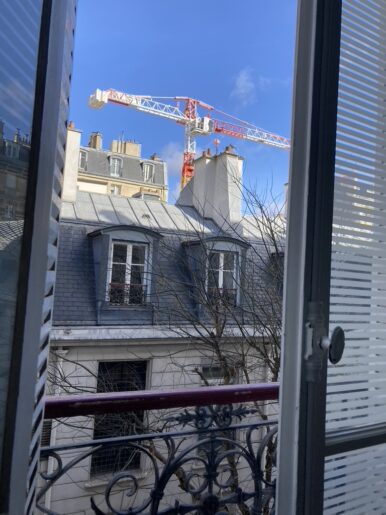
This photo is from my private room which cost 210 euros per day. The whole procedure and related lab and doctors’ appointments will likely cost 7,000 to 8,000 euros, probably much less than in the United States, although I am not yet sure of how much Medicare will reimburse.
The doctors and staff are efficient and friendly. My surgeon is a friend of old friends and speaks very good medical English, which was very helpful to me in this context. Otherwise this is a French speaking institution, part of a network of hospitals and clinics owned by a Catholic healing order, founded in Spain in the 16th century.
Everyone here is careful and meticulous. Some of the nurses and orderlies are bossy, but it hasn’t been difficult to comply or simply ask someone else. The food, excepting the bread, is not up to French standards, but that is not why I am here.
March 25
I am back in an apartment in Neuilly-sur-Seine, after a second release from the clinic, due to a complication following surgery. It was painful, but I was taken care of. The surgeon guided me, showed up, took care of me, and calmed me with his sympathy and clarity. The nurses took charge and moved me through some difficult procedures—thank you S! From Neuilly, F had rushed me to the clinic, on an emergency basis, and now F and C are keeping an eye on me. I was a difficult and frightened patient, and now a lucky one, who learned that my fear was worse than the pain, and that pain was more tolerable than I realized.
Breakfast at the clinic, Tuesday morning, was coffee, bread, butter and jam, with orange juice. It felt like the best breakfast I had ever had. It was normal and intense, and I am grateful.
March 2023, The Protests in France
I am no expert on the finances of the French social security system, but like our own budget, it is threatened by a growing number of longer-living retirees and a slowing number of earners/contributors. My reading indicates that the present deficit is projected to balloon in the coming decade and that benefits, while less than in the US in absolute terms, are more generous as a percentage of pre-retirement income.
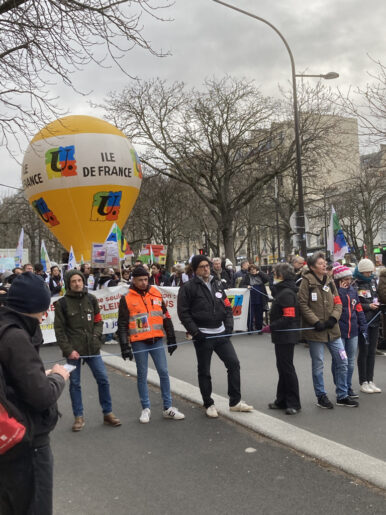
The present reform will increase the retirement age from 62 to 64 and has been approved by the French president without the National Assembly’s approval, in accordance with a provision in the constitution of the 5th Republic. However, it is still subject to the approval of the Conseil Constitutionnel (later granted).
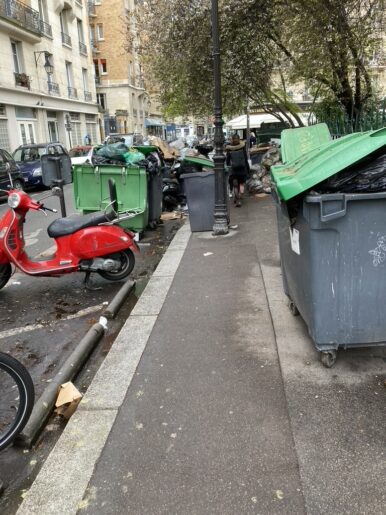
Both the implementation and the intense negative reaction have been somewhat theatrical, the president’s clear but insistent and top-down attitude a holdover from the ancien régime. The proud and insistent reaction of the unions, the demonstrators and extremist elements, is in the tradition of old revolutionary France, this with a colorful complement of burning and uncollected trash, Molotov cocktails and cobblestones. Strikes are on pre-scheduled days, a kind of contained chaos. Symbols of capitalism, that is international chain restaurants, an interesting choice, have been vandalized, and there have been injuries, of both protestors and the police, some serious.
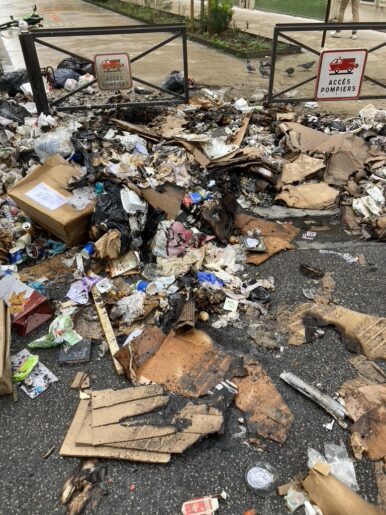
April 20, 2023 Neuilly-sur-Seine
Recuperating from surgery takes time, more so at 69 than when I was younger, but I was well cared for by my old friends, F and C who invited me to both lunch and dinner daily. No one could have been more supportive or attentive, while leaving me plenty of space to be alone. This couple is like a well oiled machine, looking after the needs of children and grandchildren, art classes, volunteer work, house maintenance, and cooking for frequent dinner guests. Their son and daughter-in-law pitched in, housing me for a week prior to the surgery in their apartment on the rue d’Aligre, after my early arrival for tests.
In the weeks following the hospitalization, I limited my movements to short walks in Neuilly, where I was staying, and later to some errands in central Paris. On one of my walks, I ran into a friend who was coming out of her front door; she and her husband invited me for coffee and a visit of their apartment and its superb garden. He reads history, including the 17th and 18th century journals of the Duc de St. Simon, which I found and downloaded on Kindle for $4 or $5. Another afternoon, I walked to the American Hospital, which caters to foreigners and the affluent. A friend had ankle surgery there a few years ago and described the food as superb. So I was expecting a grand establishment. Not at all. The hospital is large but the buildings are low key and modernist.
On another Sunday, a young friend visited, whom I knew when she and her boyfriend (now husband) were living in New York. I made her a salad and a pizza, frozen and heated in the oven, from Picard. She is now mother to a six-month old, a role that she has taken-on with calm, efficient love. She brought her baby with her, in a stroller, on the metro, and we chatted about parenting, careers, moving to Marseille, her parents, my medical issues and my writing.
Neuilly-sur-Seine was an early suburb, developed in the 19th century, with large, private villas. Now it is better described as a small town or city, at the edge of Paris, with its own city government. It is mostly five and six story apartment houses, now far outnumbering the remaining single family houses. There is a lot of planting and well-maintained municipal flower beds and trees, with in addition, private gardens surrounded by 19th century fences and walls.
Neuilly also has dense mixed-use commercial streets, nearer to the subway line and the very wide and trafficked Avenue Charles de Gaulle, which links Paris with highways and the modern office district at La Défense. Three times weekly, there is an open air market along the Avenue at Les Sablons. One day, C and I went to pick up a roast chicken, a head of lettuce, cheeses and salmon.
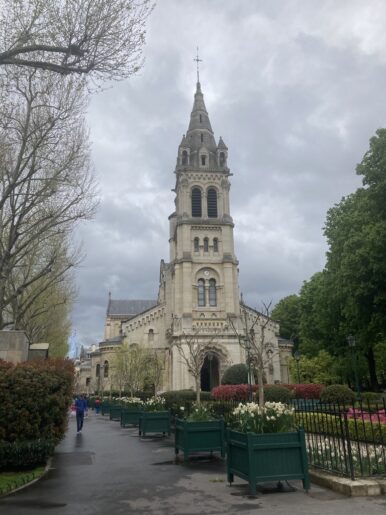
Mostly I shopped a few steps from the apartment, at the intersection of the rue Perronet and the rue de Chézy. There are a butcher, green grocer, café, bank, grocer, bakery and a traiteur. F and C are only a few doors away. I have lived here with them or visited for fifty years, and so in some sense I am at home.


Good insights of Paris. Liked the food and wine info.